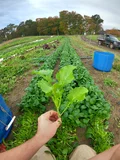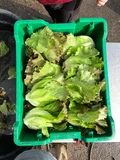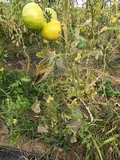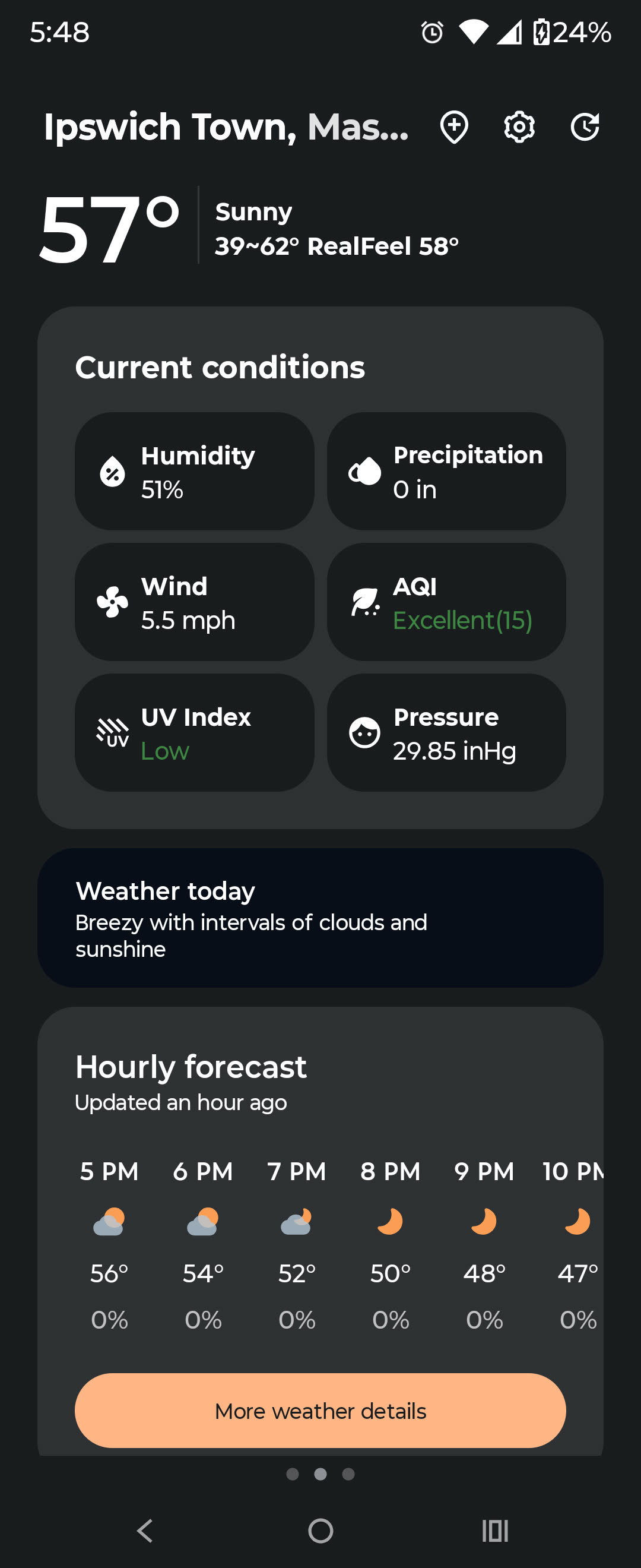TL;DR
We harvested tatsoi, mustard greens, lettuce, beets, tomatoes, and salad turnips. The sun came out for about 15 minutes. I packed delivery bags, loaded the van for market, cleaned onions, and gave water to pigs and chickens. I enjoyed my work.
Cold Start
I started the day like most days by washing bins and buckets for harvest then preparing the wash area for receiving produce from the field. After that was done, I went down to the new tatsoi patches which, after a few days of rain and then one without, the cold clay-loamy soil was practically fluffy on my knees.
I keep my own harvest knife on me at all times, a six-dollar foldable from Reny’s in Dexter. Its curved, sharp blade and safety lock are exactly what I need in most situations. The alternative is the farm’s harvest knives which are great general purpose, a bit dull due to constant use, but still get most chop-harvest jobs done. My knife is great for stemmy crops like tatsoi and bok choy but less so for leafy crops like mustard greens and spinach because the little leafy bits tend to coat the sharp edge and reduce it to a sort of tear job.
A Little Bit of Sun Today
For the first time in days, the sun finally came out over the fields. After that last few days of rainy, soggy clothes by lunchtime, a drier and warmer day was most welcomed. On cold, wet, dreary days it’s easier for me to grumble in my mind about little things, but on a good weather day I feel like I can look ahead. So the sun today gave me more head space to observe and reflect about what I was doing and seeing in the field.
As I was in the tatsoi, I noticed how weed-free it had remained. Earlier in the season, for instance, even with the FilmOrganic mulch over the onions, the weeds rapidly took hold. Granted, that was a very different time (mostly temperature) of the growing season but I would have expected weed seeds to germinate just the same as what we sowed with the wheel seeder a little over a month ago. I knew we hadn’t weeded that patch, so it was a bit surprising.
This is another thing my limited experience and thus intuition about farming gets wrong…knowing how to manage weeds in the long term. I asked Jamie about it, verbalizing my thoughts about germination ranges and rainfall, and he said that it was likely due to how quickly the broad-leaf tatsoi shaded out the ground around, not only the temperatures.
Last year I had this dumb realization that most plants evolved their underground root systems differently from their above-ground parts due to…gravity. Well, really, it’s because dirt and air are very different environments, and gravity keeps them separate (mostly). Above and below…what’s happening in both…is the operative concept here. I was thinking only about the conditions below in the soil, not above (i.e. sunshine and shading).
Commodity College
Like a community college, working on a farm teaches you things. You meet different people, you have commitments and assignments, you earn some context. Sometimes it’s a grind, sometimes you don’t want to do it. Sometimes it doesn’t feel worth the pay. But it’s definitely better than not doing it at all.
We grow and sell food because people eat. Whether organic produce is better than macro-farm vegetables is neither here nor there. People buy what they want and we provide something very different that what any supermarket can offer. A CSA is made up of people who put forward their money to be part of a community of farm-friendly economics. This food is not a commodity, but rather a choice. With sore muscles, we intentionally make sure that sustainable and natural processes like moving chicken coops around to fertilize next year’s growing soils are weaved in to the busy schedule of a limited crew. From chicken excrement and firmament arises a true sacrament: honest food through honest work from honest people.
So while the rest of the world thinks of food as a commodity, and though you can purchase a CSA share from this farm, the honesty you can’t buy in any big store is in the commitment of the people who grow and buy it. Just like the personal commitment of paying for your own courses at a community college, taking this pay cut and putting in epic amounts of hard work each day is my own personal tuition fee. The learning I get from an honest space like this is invaluable and not available from dishonest corporate greed boxes. Every onion is practice for the next big thing.
AI Summary from Field Notes
So I realized after listening back to the summary that this LLM pretty consistently ignores when I say that “someone else did this or that” and “yesterday we did X” (or “tomorrow, we will do Y”). In my audio notes, I mention that “…and moved the tractor from where we had left it yesterday while moving the chicken coops then, I moved the tractor back to the main field” but in the Part 1 activities it captures both “Moved the tractor and chicken coops”, even though I specifically mention that we moved the coops yesterday.
It’s almost like it has no sense of time or other people on the team. Yet when I mention that “Jamie and I did this or that”, it seems to keep the combination between a proper name and myself, so certain types of concepts are being connected. I’m going to have to think about the testability of the LLM’s understanding of time and team coordination. Once I do some more rigorous testing, I might even reach out to my old friend James Bach to get his thoughts on the whole thing. Because, even at this last sentence, LLMs are so biased against true testing that it thinks all it takes to make a test work is to adjust the inputs:
(LLM suggestion of what to write above) “Once I do some more rigorous testing, I can start to understand how to better structure my input to get the desired output.”
Yeah, it’s not the system’s fault, it must be something the user is doing wrong. I probably will end up as some of that, but for now I’ll leave the coop thing crossed out in the LLM-generated summary below:
Summary
Consolidated Summary:
Main Themes:
- Farm Operations: Daily crop harvesting, bin cleaning, and field maintenance.
- Logistics & Transportation: Managing delivery orders, loading/unloading vehicles, and coordinating with external locations (e.g., Gloucester market, Ipswich CSA).
- Team Coordination: Collaborating with team members (e.g., Jamie) for tasks like wood chip delivery, CSA pickups, and market trips.
- Crop Management: Harvesting and preparing multiple crops (tatsoi, mustard greens, lettuce, beets, turnips, tomatoes).
Activities Performed:
- Cleaned blue and green bins.
- Harvested tatsoi, mustard greens, lettuce, beets, turnips, and tomatoes.
- Moved tractor and chicken coops.
- Peeled onions and maintained pig/chicken water systems.
- Packed delivery bags for nine locations.
- Loaded electric van for Gloucester market.
- Bagged tatsoi (20 bags).
- Assisted with Ipswich CSA pickup (4–6 PM).
- Coordinated wood chip delivery for new chickens.
New Tasks/Experiences:
- Wood Chip Delivery: New logistical task for chicken feed.
- CSA Pickup Coordination: Planning and timing for Ipswich CSA.
- Multi-Location Delivery: Managing delivery routes for nine locations.
Questions for Future Research:
- How to ensure timely wood chip delivery for new chickens?
- How to optimize CSA pickup scheduling to avoid conflicts with other tasks?
- How to improve team communication for efficient task coordination?
- Can harvesting multiple crops (e.g., tatsoi, mustard greens) be streamlined?
Suggested Actions:
- Streamline Delivery Scheduling: Plan wood chip delivery and CSA pickup to avoid time conflicts.
- Improve Team Communication: Clarify roles (e.g., van loading/unloading) to reduce delays.
- Document New Tasks: Record wood chip delivery and CSA processes for future reference.
- Optimize Crop Harvesting: Explore tools or methods to increase efficiency for multiple crops.
Part 1
Main Themes:
- Farm Operations and Harvesting: Daily tasks involving crop harvesting, bin cleaning, and field maintenance.
- Logistics and Transportation: Managing delivery orders, loading/unloading vehicles, and coordinating with external locations (e.g., Gloucester market, Ipswich CSA).
- Team Coordination: Collaborating with team members (e.g., Jamie, the person at Route 1) for tasks like wood chip delivery, CSA pickups, and market trips.
- Crop Management: Harvesting and preparing multiple crops (tatsoi, mustard greens, lettuce, beets, turnips, tomatoes).
Activities Performed by the Intern:
- Cleaned blue and green bins (likely for storage or market use).
- Harvested tatsoi, mustard greens, and head lettuce.
- Picked beets and salad turnips.
- Moved the tractor ~
and chicken coops.~ - Harvested tomatoes from the greenhouse.
- Peeled and cleaned onions.
- Packed delivery order bags for nine locations.
- Loaded the electric van for the Gloucester farmers market.
- Bagged tatsoi (20 bags).
- Assisted with the Ipswich CSA pickup (4–6 PM).
- Maintained pig and chicken water systems.
New Things Not Yet Encountered:
- Wood Chip Delivery: The intern was tasked with coordinating the pickup of wood chips for new chickens, which is a new logistical task.
- CSA Pickup Coordination: The Ipswich CSA pickup required planning and coordination with Jamie, involving a specific time window (4–6 PM).
- Multi-Location Delivery: The intern packed bags for nine locations, which may involve unfamiliar delivery routes or customer interactions.
Questions and Future Research Areas:
- Efficiency of Wood Chip Delivery: How to ensure the wood chips are delivered in time for the new chickens.
- CSA Pickup Scheduling: How to optimize the timing for the Ipswich CSA pickup to avoid conflicts with other tasks.
- Logistical Coordination: How to better coordinate the team’s movements between the market, CSA, and farm tasks.
- Crop Harvesting Efficiency: Could the intern or team streamline the harvesting process for multiple crops (e.g., tatsoi, mustard greens, lettuce).
Suggested Actions:
- Streamline Delivery Scheduling: Plan the order of tasks (e.g., wood chip delivery, CSA pickup) to avoid time conflicts.
- Improve Team Communication: Clarify roles (e.g., who is responsible for loading/unloading the van) to reduce delays.
- Document New Tasks: Record the wood chip delivery and CSA pickup processes for future reference.
- Optimize Crop Harvesting: Explore tools or methods to make harvesting multiple crops (e.g., tatsoi, mustard greens) more efficient.
[end of post]
Enjoy Reading This Article?
Here are some more articles you might like to read next:








